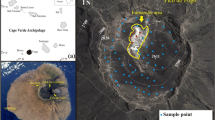Abstract
We began continuous monitoring of H2 concentration in soil along the San Andreas and Calaveras faults in central California in December 1980, using small H2/O2 fuel-cell sensors. Ten monitoring stations deployed to date have shown that anomalous H2 emissions take place occasionally in addition to diurnal changes. Among the ten sites, the Cienega Winery site has produced data that are characterized by very small diurnal changes, a stable baseline, and remarkably distinct spike-like H2 anomalies since its installation in July 1982. A major peak appeared on 1–10 November 1982, and another on 3 April 1983, and a medium peak on 1 November 1983. The occurrences of these peaks coincided with periods of very low seismicity within a radius of 50 km from the site. In order to methodically assess how these peaks are related to earthquakes, three H2 degassing models were examined. A plausible correlational pattern was obtained by using a model that (1) adopts a hemicircular spreading pattern of H2 along an incipient fracture plane from the hypocenter of an earthquake, (2) relies on the FeO−H2O reaction for H2 generation, and (3) relates the accumulated amount of H2 to the mass of serpentinization of underlying ophiolitic rocks; the mass was tentatively assumed to be proportional to the seismic energy of the earthquake.
Similar content being viewed by others
References
Coleman, R. G.,Ophiolites — Ancient Oceanic Lithosphere? (Springer Verlag, Berlin, New York 1977), 229 p.
Cowan, D. S., andMansfield, C. F. (1970),Serpentine Flows in Joaquin Ridge, Southern Coast Ranges, California, Geol. Soc. Am. Bull.81, 2615–2628.
Eugster, H. P., andWones, D. R. (1962),Stability Relations of the Ferruginous Biotite, Annita, J. Petrology3, 82–125.
Francis, T. J. B. (1981),Serpentinization Faults and Their Role in the Tectonics of Slow Spreading Ridges, J. Geophys. Res.86, 11, 616–11, 622.
Giardini, A. A., Subbarayudu, G. V., andMelton, C. E. (1976),The Emission of Occluded Gas from Rocks as a Function of Stress: Its Possible Use as a Tool for Predicting Earthquakes, Geophys. Res. Lett.3, 355–358.
Hess, H. H. (1955),Serpentines, Orogeny, and Epeirogey, Geol. Soc. Am. Spec. Paper62, 391–407.
Jiang, Fong-Liang, andLi, Gui-Ru (1981),The Application of Geochemical Methods in Earthquake Prediction in China, Geophys. Res. Lett.8, 469–472.
Kita, I., Matsuo, S., andWakita, H. (1982),H 2 Generation by Reaction Between H 2 O and Crushed Rocks: An Experimental Study in H 2 Degassing from the Active Fault Zone, J. Geophys. Res.87, 10, 789-10, 795.
Lachenbruch, A. H., andSass, J. H. (1980),Heart Flow and Energetics of the San Andreas Fault Zone, J. Geophys. Res.85, 6185–6222.
Nur, A. (1972),Dilatancy, Pore Fluids and Premonitory Variations in T s /T p Travel Times, Bull. Seismol. Soc. Am.62, 1217–1222.
O'Neal, J. R., andHanks, T. C. (1980),Geochemical evidence for water-rock interaction along the San Andreas and Garlock faults in California, J. Geophys. Res.85, 6286–6292.
Robie, R. A., Hemingway, B. S., andFisher, J. R. (1978),Thermodynamic Properties of Minerals and Related Substances, Geological Survey Bull. 1452, U.S. Gov. Print. Office, Washington, D.C.
Sato, M., andMcGee, K. A. (1982),Continuous Monitoring of Hydrogen on the South Flank of Mount St. Helens, inThe 1980 Eruptions of Mount St. Helens, Washington, U.S. Geological Survey Prof. Paper 1250, 209–219.
Schrader, R., Wissing, R., andKusch, H. (1969),Zur Oberflächenchemie von mechanisch activierten Quarz, Z. Anorg. Allg. Chemie365, 191–198.
Shaw, H. R.,Hydrogen Osmosis in Hydrothermal Experiments, inResearches in Geochemistry, vol. 2 (ed. P. Ableson) (Wiley, New York 1967), 521–541.
Sugisaki, R., Ido, M., Takeda, H., Isobe, Y., Hayashi, Y., Nakamura, N., Satake, H., andMizutani, Y. (1983),Origin of Hydrogen and Carbon Dioxide in Fault Gases and its Relation to Fault Activity, J. Geology91, 239–258.
Vielstich, W.,Fuel Cells (Wiley-Intersciences, London, New York 1965), 501 p.
Wakita, H., Nakamura, Y., Kita, J., Fujii, N., andNotsu, K. (1980),Hydrogen Release: New Indication of Fault Activity, Science210, 188–190.
Wenner, D. B., andTaylor, H. P., Jr. (1973),Oxygen and Hydrogen Isotopic Studies of the Serpentinization of Ultramafic Rocks in Oceanic Environments and Continental Ophiolite Complexes, Am. J. Sci.273, 207–239.
Wenner, D. B., andTaylor, H. P., Jr. (1974),D/H and O 18 /O 16 Studies of Serpentinization of Ultramafic Rocks, Geochim. Cosmochim. Acta38, 1255–1286.
Author information
Authors and Affiliations
Rights and permissions
About this article
Cite this article
Sato, M., Sutton, A.J. & McGee, K.A. Anomalous hydrogen emissions from the San Andreas fault observed at the Cienega Winery, central California. PAGEOPH 122, 376–391 (1984). https://doi.org/10.1007/BF00874606
Received:
Revised:
Accepted:
Issue Date:
DOI: https://doi.org/10.1007/BF00874606




